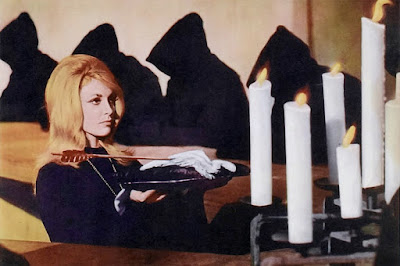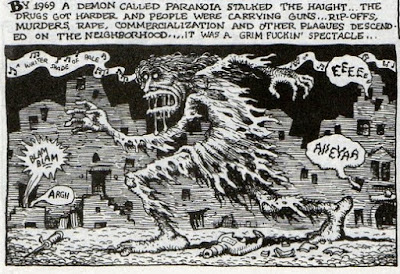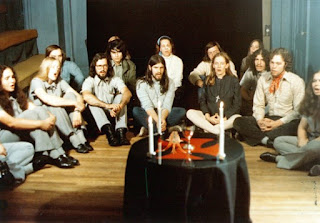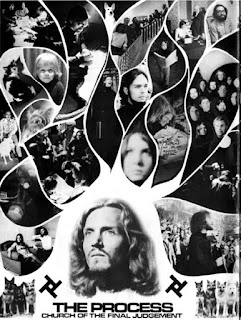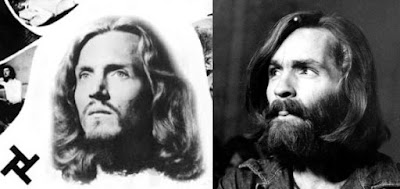Did you ever dream about a place you never really recall being to before? A place that maybe only exists in your imagination? Some place far away, half remembered when you wake up. When you were there, though, you knew the language. You knew your way around. That was the Sixties. No. It wasn’t that either. It was just ’66 and early ’67. That’s all there was. – Terry Valentine, The Limey
As we’ve seen–and as other articles have made note of — Stranger Things centers on the fictional events of a real-life program, the CIA’s MK-ULTRA experiments.
But what if they’re telling the wrong story?
What if the kinds of disruptions fictionalized in Stranger Things actually took place on a much larger scale, but not under the aegis of MK-ULTRA but in fact under the considerably more arcane and secretive MK-OFTEN?
Which interpretation is correct?
The siege got so bad that the Diggers- one of the original counterculture sects- famously staged “The Death of Hippie” for the battalion of reporters descending on the city.
Grissom’s family claimed was deliberately set to silence the astronaut, a prominent critic of the Apollo program. A virtual of parade of astronauts and NASA employees would meet similar ends in the coming years.
Detroit- the great workshop of American industry- was mortally wounded, and competition from Japan and Germany, as well as Globalist outsourcing, would deliver its death blow in the 1980s.
Later a claim would be made that the war was simply an exercise, a program for the officer corps to acquire the combat experience needed for the hot war with the Soviet Union that Powers-That-Be felt was inevitable in the 1960s.
As the war effort faltered, the CIA instituted Operation Phoenix, a program of torture, terror and political assassination.
Hell, if you really want to get picky about it you can trace the counterculture back to the Anabaptists. And beyond.
This conspiracist theory of the counterculture was first proposed in 1978 by neoconservative columnist David Goldman (aka “Spengler”) in the book Dope, Inc., published by the Lyndon LaRouche organization, but has been revived more recently by other researchers.
The current take on Goldman’s thesis has it that the CIA created the psychedelic movement to depoliticize the youth movement, and turn them all into navel-gazing couch potatoes and/or anti-modern cavemen.
antiwar protesters in 1967
And to the caveman bit, Deadheads would play no small part in the personal computer and Internet revolutions. As would acidheads like Steve Jobs.
And the protest movements? Cops, hardhats and bikers were beating up on antiwar protesters nearly from day one, despite the frankly-bizarre modern mythology of a respectable movement grudgingly admired by its opponents.
ALL YOU NEED IS CASH
At the height of the Summer of Love and the popularity of the band’s Sgt. Pepper’s Lonely Hearts Club Band album, (George) Harrison, (Derek) Taylor and their small entourage visited the international “hippie capital” of Haight-Ashbury, in San Francisco, on 7 August.
Harrison had expected to encounter an enlightened community engaged in artistic pursuits and working to create a viable alternative lifestyle; instead, he was disappointed that Haight-Ashbury appeared to be populated by drug addicts, dropouts and “hypocrites”.
Following his return to England two days later, (Harrison) shared his disillusionment about Haight-Ashbury with John Lennon, soon after which the Beatles publicly denounced the popular hallucinogen LSD (or “acid”) and other drugs in favour of Transcendental Meditation under Maharishi Mahesh Yogi.
The band would decamp to India to study TM with the Maharishi shortly after. Accompanying them would be none other than Mia Farrow.
The Stones’ very tardy foray into psych, Their Satanic Majesty’s Request, was roundly panned on release and seen as the final nail in the movement’s coffin.
In 1968, Psychedelia was out and rootsy blues and country rock and folky singer/songwriter music were on the ascendant in mainstream circles.
The Grateful Dead were a commercial nonentity until they ditched psych for country-rock (on David Crosby’s suggestion that the Dead return to the simple folk songs that first inspired them to play because their music had gotten too “far out”) on Workingman’s Dead in 1970. Pink Floyd remained an underground act until their lounge-rock move on Dark Side of the Moon.
Tarty Carnaby Street mod getups were ditched towards the end of 1967 in favor of updated versions of the Davy Crockett and Tonto outfits popular with suburban kids in the 1950s, along with ironic appropriation of surplus military gear filtering into local Army/Navy discount outlets.
“Authenticity” was the new grail, not innerspace exploration. Or did all this signal a return to the simple pleasures of Fifties American childhood after the nerve-wracking uncertainty of psychedelia?
Bands started playing faster and louder and longer as the new drugs took hold, setting the stage for early heavy metal.*
But speed soon gives rise to paranoia and aggression (it was, after all, manufactured by the Nazis for use by the Wehrmacht and Luftwaffe). As the bad vibes festered, many of the more ideological hippies began decamping from the cities and forming communes in rural areas.
Those who stayed behind would be swamped by the tidal wave of Golden Triangle heroin that started flooding American cities at the end of the 1960s.
Kind of like today.
GOING SOFT
Nearly all of them were part of the so-called “soft rock” movement, the radio-friendly reaction against “acid rock” (a catch-all phrase for guitar-based hard rock that lingered into the 70s) which the record companies pushed relentlessly in the late 60s and early 70s, forcing most of the harder rock bands off the airwaves.
Dozens of previously successful rock ‘n’ roll acts, deprived of oxygen, broke up or faded into obscurity. The next wave of hard rock bands would make their bones by constant touring and often, outrageous gimmicks and/or stage shows to get attention (Alice Cooper, KISS, Queen, Blue Oyster Cult).
The CIA and the MK-ULTRA program certainly had more than their share of connections to the counterculture and the drug movement, but careful analysis shows it was an exploitation of, and interference with, a milieu that had been established for a very long time and had caused no end of mass moral panics long before there even was a CIA.
With the media-darling Church of Satan, the mysteriously-flush Process Church and Ford Foundation and Getty-funded Kenneth Anger all up and running in 1966 (or “Year Zero”), another pawn would be put onto the board.
By the end of the 60s he’d place the counterculture in an entirely different light for America’s Silent Majority.
(The Process Church) set up a church at 407 Cole Street. Their neighbour at 636 Cole was someone who would cause them a lot of grief in a year or so. His name was Charles Manson, soon to become the head of the Family responsible for the gruesome Tate-Labianca murders in August of 1969. At that time,
Charlie was still an ex-con petty thief, strumming a guitar among the debris of the flower children, languishing amidst the ruins of the Summer of Love. By the end of the decade he was one of the most famous people alive, a cause célèbre in the counter-culture, Satan incarnate for the Establishment.
But, curiously enough, Manson would go from being just another drifter and ex-con to a mind-controlling apocalyptic ideologue after his alleged encounters with the Process.
One of the more controversial assertions I’ve heard suggesting contact between Manson and The Process comes courtesy of John Parker’s Polanski, which claims that Manson was a regular visitor at The Process headquarters on Cole Street, “reaching the fourth of the six levels of initiation, that of ‘prophet.’” At the end of 1968, he was established as a leader of a group which he called “Satan’s Slaves.”
Beausoleil would head for LA when things went sour with Anger, who put a curse on his young protege. There Beausoleil would move in with a school teacher and part-time drug dealer named Gary Hinman.
THE TEMPLE
“In one of our conversations during the Tate-Labianca trial, I asked Manson if he knew Robert Moore, or Robert DeGrimston. He denied knowing DeGrimston, but said he had met Moore. ‘You’re looking at him,’ Manson told me. ‘Moore and I are one and the same.’- Vincent Bugliosi
The group subscribed to a grim, apocalyptic view of the world precipitated by race wars, and the prophecy made a lasting impression on Charles Manson, who passed through the lodge.
So the Manson picture becomes a little clearer. He wasn’t just some random ex-con, he had contact with Scientologists on the inside, and the powerful, apocalyptic cult mind-control of the Process and the Solar OTO when he got out.
That goes a long way in explaining what he became.
Now, you don’t need to fall in with some of the more outlandish theories about the Process Church or the OTO’s involvement in the Manson killings to recognize the toxic power of the propaganda they were pumping out (in especially powerful form, in the case of the Process), the effect it had on marginal characters like Manson or the dodgier details of their CVs.
There’s far too much smoke hovering around the Process to dismiss them as just another nutty but harmless cult. And there is certainly more than enough evidence to speculate that they were a front for a much nastier operation, as these groups so often are.
Levin originally wanted the story to be about a woman who gave birth to an alien, but felt The Village of the Damned had already cornered that market.
Anton LaVey would make a number of claims of involvement with Rosemary, all of which were denied by its producers.
What should be noted is that the Signal Corps conducted Project Diana, in which radar signals (radar again) were bounced off the Moon, at the exact same time Jack Parsons and L. Ron Hubbard- then both members of the Agape Lodge of the OTO- were conducting the Babalon Working, whose ultimate goal was to give birth to the Antichrist.
Just a little coincidence for you to chew on there.
1966 alone saw two British films dealing with secret satanic cults: Nigel Kneale’s The Witches, which had a teacher discover a human-sacrifice cult in a small town, and the similarly-themed Eye of the Devil, which starred David Niven, David Hemmings and Sharon Tate.
In fact, Anton LaVey is in many ways responsible for the novel and film’s success, since he did so much to put Satanism on the front burner in 1966, along with the national media and whoever was backing him and his organization.
It’s possible- even probable– LaVey’s notoriety inspired Levin to write the book in the first place.
The ep was directed by (MKULTRA chemist) Andrija Puharich’s protege John Newland, an influential industry figure who took magic mushrooms on national television on his anthology series, One Step Beyond.
In 1961.
“Errand’s” storyline came straight out of the original Round Table Nine channelings, just in case there was any doubt what was being processed here. Evidence that Puharich had moved his operation under the OFTEN aegis will be explored later in this series.
One of the tells? The planets being named after zodiacal signs, anathema to a devout Mormon like Larson but a no-brainer to an occult-drenched operator like Stevens.
And what’s this?
Oh.
Think about that before your next Outer Limits rewatch, with its numerous Paperclip, MKULTRA and MJ12 allusions (long before the public at large knew of any of these programs).
Telling tales out of school, indeed.
Kneale leavened his AAT with heavy doses of occultism and devilry, a brew that undoubtedly gave the story a much harder kick than it might have otherwise carried (see Ancient Aliens for contrast).
The Invaders, Quinn Martin’s prestige treatment of the UFO issue starring Roy Thinnes and a roll call of TV’s frontline character acting talent, made its debut in January of 1967. The series would run for only two seasons but would reach a cult following in Europe and South America.
on The Invaders’ series finale
Skeptics have attacked the unlikely convenience of its very existence as well as the human-like gait of the creature. Advocates have noted longheld reports from Native Americans that Sasquatch “walked like a man” and pointed to the anatomical anomalies (the pendulous breasts, the disproportionate arms) and the naturalism of the hair.
When that argument failed, elusive hordes of scapel-waving Satanic cultists were fingered for the killings.
Were the producers of Stranger Things referencing these killings- consciously or otherwise- with the monster’s predation of deer?
*Detroit’s MC5, who were faster, louder and more radical than anybody else at the time, played for eight hours outside the Democratic National Convention in Chicago in 1968. Two of the three key members would die of heart failure in their mid-40s. The third went to prison for dealing cocaine.

